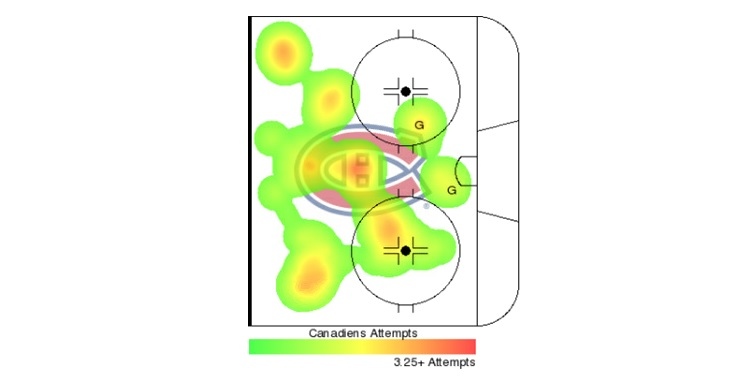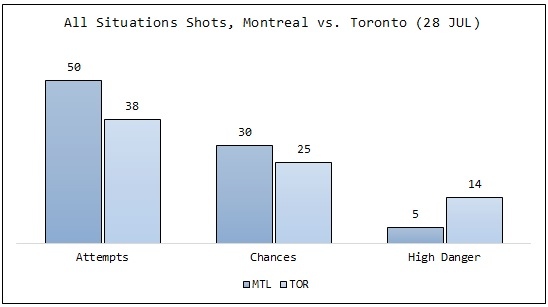Jul 29, 2020
Habs plagued by familiar problems in exhibition loss to Leafs
The Montreal Canadiens will be in the draft lottery queue rather quickly if the team can’t find answers for a couple of glaring offensive issues, Travis Yost writes.
By Travis Yost

For the Montreal Canadiens, this postseason appearance is an unexpected surprise. The team sat 24th in the National Hockey League at the pause and were pacing to finish the regular season with 82 points.
Considering their upcoming matchup – they are set to take on the Pittsburgh Penguins, arguably the best team featured in the play-in round – expectations are relative. But the good news is that Montreal is facing a win-win scenario. The Canadiens will either lose in the play-in round and get a one-in-eight chance at landing a potential superstar in the form of Alexis Lafreniere in the Entry Draft, or they will pull off a shocking first-round upset.
While an upset seems unlikely, it’s not as if Montreal is without capabilities. This is a team that outscored opponents at 5-on-5 this season (+5, 12th in the NHL), better than a number of respectable playoff contenders like the Toronto Maple Leafs and Dallas Stars. And any time you have Carey Price in net you have a chance – even if his performance has started to dwindle with time.
But the concerns that plagued Montreal all season long resurfaced once again during Tuesday’s exhibition game against Toronto. The Canadiens out-attempted the Maple Leafs 37-28 and broke even in goals at even strength, but gave up a pair of short-handed goals and lost the game 4-2.
The first of two critical issues observed during the game was Montreal’s inability to pierce the interior of the opposition’s defence. Despite having the majority of puck control, the Canadiens generated most of their shots from the perimeter.
The two goals they did score – one from Paul Byron, the other from Tomas Tatar on a slick feed from Nick Suzuki – were two of only a handful of shots within close proximity of Leafs goaltender Frederik Andersen:

A decisive shot advantage tends to mean a decisive goal advantage, but not when the majority of shots are from distance.
Looking closer at the data, the Maple Leafs – who also looked off from time to time in the offensive zone – were much more effective at getting to Price’s doorstep.
Consider what happens when we break the shot attempt data down. Let’s look at all situations to ensure that special teams are enveloped:

Montreal goes from a +12 shot attempt advantage (good!) to a -9 dangerous shot disadvantage (bad!). Perhaps more concerning is the fact that Brendan Gallagher owned the lion’s share of those dangerous shots. That plays on another pressing issue facing the Habs: Where exactly will the offence come from when Montreal’s top line is resting?
There is one other obvious issue, and that’s how Montreal gave up two goals on power plays. Every team is going to need some degree of spool up time, which is why there are exhibition games being played this week. Giving up a pair of goals while on the man advantage certainly reeks of rust.
The goals were a killer, but it’s even more concerning that the Canadiens generated just two dangerous shots in more than 12 minutes of power-play time.
This is an extension of what we saw all season long, with both power-play units ineffective at carrying through the neutral zone and holding the offensive third. Montreal was 26th in shot generation, 26th in expected goals and 24th in goal scoring. This is a team that had two forwards – Tatar and Suzuki – account for half of the team’s power-play scoring.
All this to say: It’s just one exhibition game and Montreal still has a bit of time to shake off nearly five months of rust, but the struggles the Canadiens had against the Maple Leafs Tuesday night were collinear with what killed the team all season long.
The Canadiens will be in the draft lottery queue rather quickly if that holds in the opening round against the Penguins.


